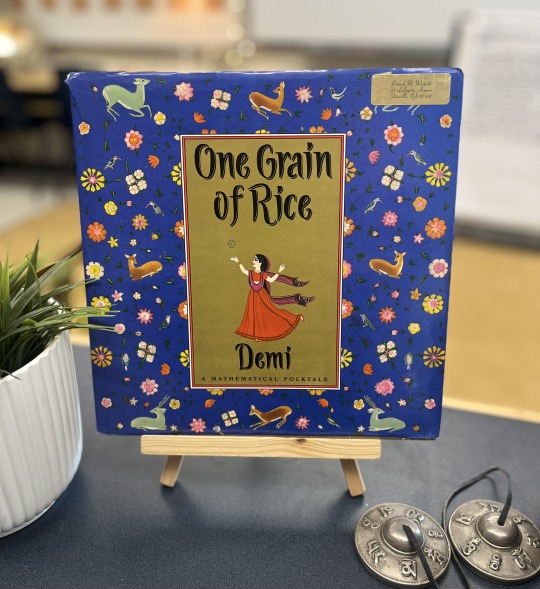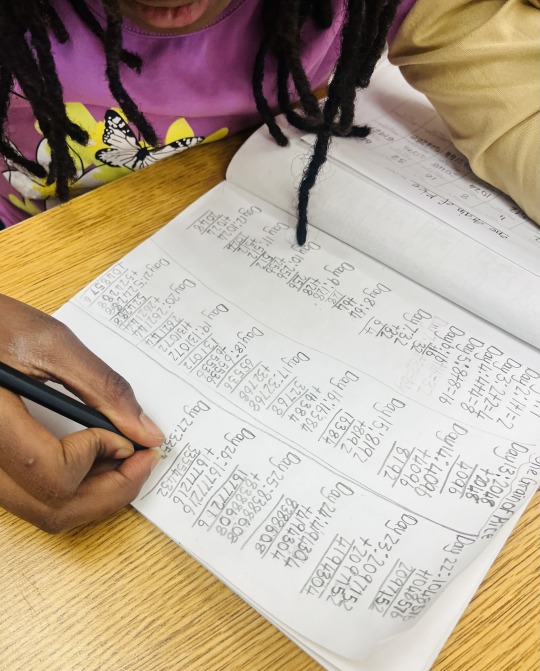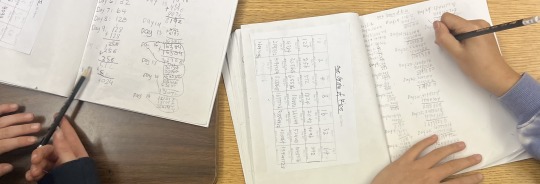This blog is a way to document my journey as a grade 2 teacher and graduate student in Education.
Don't wanna be here? Send us removal request.
Text



An Indian Raja made a deal to give a girl named Rani one grain of rice doubled each day for 30 days. This beautiful story is a wonderful mathematical inquiry! With grade four children, we explored this book in depth. How many grains of rice did Rani receive after 30 days? Did she make a good deal? Lots of great discussion and addition operations emerged from this exploration!
4 notes
·
View notes
Photo




The Door To Freedom: A Statue Created by Grade 3 Children To Welcome New Refugees
The children in my grade 3 classroom were struck by Syria’s struggles and the fact that so many people fro Syria were forced to leave their homes and many were coming to Canada. They had many questions and compassionate thoughts. Many of them couldn’t understand the issue - “I have a spare room,” one boy said. “So do I!” “Me too!” They were all ready to help.
Initially, the children wanted to raise money for the refugees coming to Canada. We began raising money in our school for the CCIS (Calgary Catholic Immigration Society). With the help of our school, we raised $1000.
After the fundraiser, the children spoke of wanting a symbol to put in Calgary so that new refugees would feel welcome. They felt that money was nice, but a lasting symbol would make them feel welcome for longer. This is where our Door to Freedom statue was created. The children made many plans of possible statue ideas. From doves, to kites to God’s hands, they had many beautiful ideas. After many classroom discussions and sketches, this door is what unfolded.
One side represents a refugee’s homeland and the other side represents Canada. They wanted to show the darkness of a refugee’s homeland but also wanted to show that it was home and a place of love and memories for refugees before war, violence, etc. The other side shows a welcoming and safe place where refugees can feel peace, but also has traces of memories of what they have been through (dark lines around the door and photo from home).
The children and their deep understanding and compassion for refugees and ensuring they feel welcome was truly remarkable to witness and a beautiful learning experience for all of us.
We are now looking for a home for our statue - if you know of a fitting place in Calgary, please let us know.
2 notes
·
View notes
Quote
Tell me you remember you are still a human being, not just a human doing. Tell me you’re more than just a machine, checking off items from your to-do list.
Omid Safi from “The Disease of Being Busy”
3 notes
·
View notes
Quote
How is your heart doing at this very moment, at this breath? I am not asking how many items are on your to-do list, nor asking how many items are in your inbox. I want to know how your heart is doing, at this very moment. Tell me. Tell me your heart is joyous, tell me your heart is aching, tell me your heart is sad, tell me your heart craves a human touch. Examine your own heart, explore your soul, and then tell me something about your heart and your soul. Tell me you remember you are still a human being, not just a human doing. Tell me you’re more than just a machine, checking off items from your to-do list. Have that conversation, that glance, that touch. Be a healing conversation, one filled with grace and presence.
Omid Safi, from “The Disease of Being Busy”
3 notes
·
View notes
Quote
Wendell Berry’s writing is a refreshing and rare change in the way that it deals in acceptance. In a recent interview with Bill Moyers, Berry said that, “to be patient in an emergency is a terrible trial,” but that “the situation [we're] in now is a situation that’s going to call for a lot of patience.” Somehow, this feels far more possible and rewarding to me than raging against the world. A lot of terrible things are bound to happen and are already happening. I want to help limit those terrible things in whatever way I can. But I can only do that in trying to live well myself, not in fighting tooth and nail against the inevitable aspects of the future. Not in laying the blame for those inevitabilities at the feet of others in favor of myself.
http://ofthehands.com/2013/11/04/patience-in-an-emergency/
1 note
·
View note
Text
Why We Tell Stories
1 Because we used to have leaves and on damp days our muscles feel a tug, painful now, from when roots pulled us into the ground and because our children believe they can fly, an instinct retained from when the bones in our arms were shaped like zithers and broke neatly under their feathers and because before we had lungs we knew how far it was to the bottom as we floated open-eyed like painted scarves through the scenery of dreams, and because we awakened and learned to speak 2 We sat by the fire in our caves, and because we were poor, we made up a tale about a treasure mountain that would open only for us and because we were always defeated, we invented impossible riddles only we could solve, monsters only we could kill, women who could love no one else and because we had survived sisters and brothers, daughters and sons, we discovered bones that rose from the dark earth and sang as white birds in the trees 3 Because the story of our life becomes our life Because each of us tells the same story but tells it differently and none of us tells it the same way twice Because grandmothers looking like spiders want to enchant the children and grandfathers need to convince us what happened happened because of them and though we listen only haphazardly, with one ear, we will begin our story with the word and Lisel Mueller
3 notes
·
View notes
Quote
Rich classroom work teaches us not just something about this or that particular topic, but something about the worth of whiling over itself and what it requires of us and what happens when we strive to surround ourselves and fill our lives with things worthy of spending our lives on.
- David Jardine
1 note
·
View note
Photo

Our class inukshuk, representing our classroom community.
1 note
·
View note
Quote
[It] runs through every moment of existence, about the fleetingness of lives lived in a world where nothing can be saved. [It is] entering that state of being with a joy and wonder that comes from that very impermanency, from the absolute dispossession of everything we love and cherish. The wonder is that anything at all exists. The joy is that it does, even if it is as momentary as a human life. We can live this as a mode of attention, we can live within its movements, its cycles and treasure the phases, the round of it. (p.246)
Canadian poet, Don Domanski (2002)
1 note
·
View note
Quote
It's not enough to teach design in schools. We must still make the school a museum, a kind of sanctuary where there is beauty as well as science and virtue. Let the child live, surrounded by noble works that constantly speak to him, arousing his curiosity, raising his soul. Art must come to him from almost all sides as the air he breathes.
Charles Bigot - 1880
2 notes
·
View notes
Quote
"In our system of education, knowledge is earned. One learns to listen, like a human being who has the gift to hear what is said. We don't put knowledge in a person's head or hand. We give directions, not answers. We don't trap people into thinking answers are given from the outside. Answers come from the inside."
Wes Fineday: First Nations Elder
1 note
·
View note
Photo

Collaborative sand mandala project.
1 note
·
View note
Text
The Filled in Worksheet
The Filled In Worksheet
inanimate
stagnant
and unforgiving.
ripped edges
tattered wonders
bent corners
wilting creativity
fill in the blanks
of your narrowing minds
creative doodles
confined to an edge
claustrophobic beauty
a crying out for real work.
in a monochrome classroom
nearly identical papers
are disposed of with ease
tossed into the melting pot.
temporarily absolved of the tedium
of filled in worksheets
the children breathe
for a moment.
“A pitcher cries for water to carry,
and children for work that is real.”
- Marge Piercy
0 notes
Photo



As part of our investigation into the First Nation peoples of the plains, the children decided that we needed to make a big teepee in our classroom. Here she be!
1 note
·
View note
Text
My Pedagogy
A Pedagogy of Peace, Wonder & Wisdom is... - imaginative engagement that invites children most fully into the club of knowers; not at some unspecified time in the future, but now and each and every day they spend with us - time for having love, being creative and for living life - making ourselves home in the world together - The movement of bodies and minds not stifled by hard desks and narrow minds and rigid purposes - a curriculum that remembers - like the pitcher, crying for water to carry, and us, for work that is real - it is curriculum as plan waiting at the door for an invitation - becoming one with the dusty world - to ask: is there life here? - learning that is sustained by life itself - creating something beautiful that is worth whiling over - an education of attention - learning how to carry ourselves in a way that the ways of this place might show themselves - together, becoming something through what we know and what we learn - enlivening that which seemed routine, deadened and lethal - living in the belly of a paradox wherein a genuine life together is made possible only in the context of an ongoing conversation which never ends yet which must be sustained for life together to go on at all - learning from place - being mindful, learning to be sustained by life - coming together to be together, not just to go about our own business in the same space - an open sense of time and its gathering - ongoing conversations that never end - experiencing the world together - an abounding hereness - remembering we are in life, squeeze it, cherish the difficult way - it is digging up the wisdom that sits in places - an education of awareness - learning a place by dwelling and traveling in that place - mindful, deliberate improvisation - being at home in a good way, a more creative way, a healthy way, a way tuned to the deepest truth of things - being hungry for a simple love of the world itself as our earthly home - genuine conversation - gaining a sense that the human world is a construction that can be entered and engaged creatively - invitations to walk in places where we have been but never been - a journey...
1 note
·
View note
Photo

The Prairies: Using the book "A Tallgrass Prairie Alphabet" each child chose a picture to inspire their artwork. Then each child represented the prairies using chalk pastel on black paper.
0 notes
